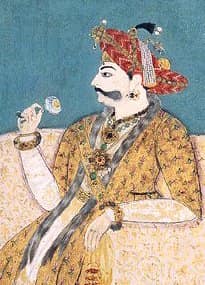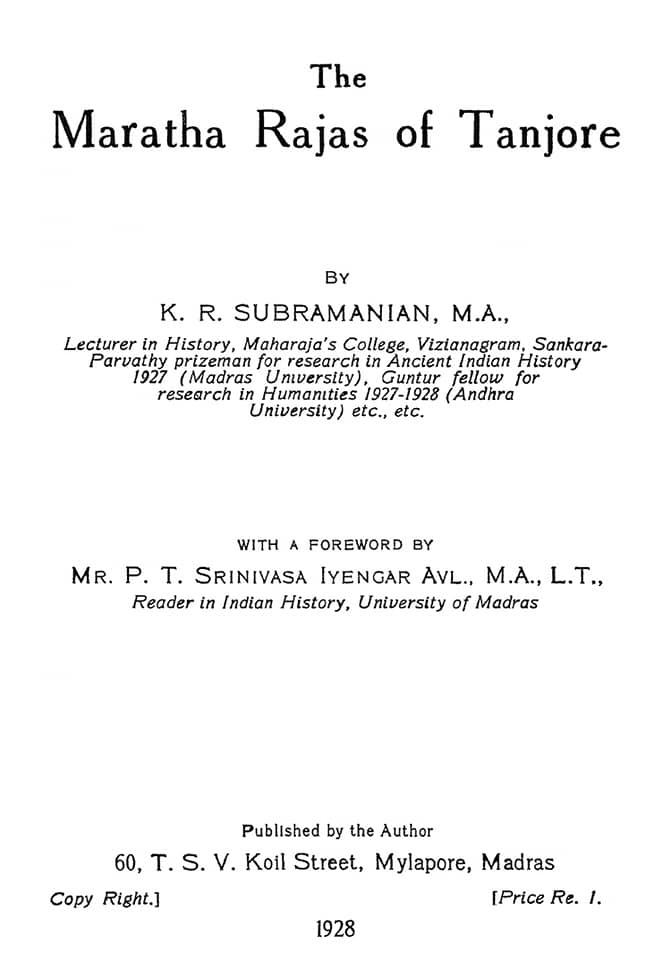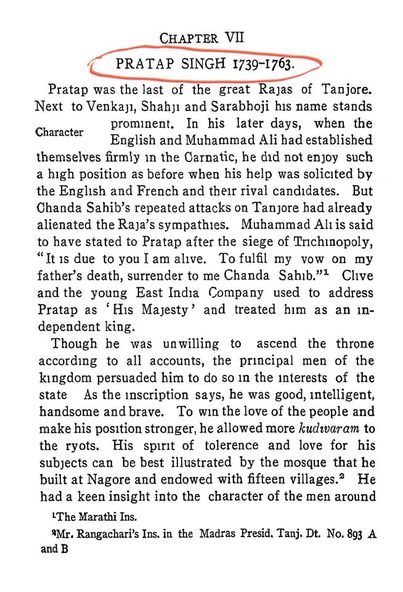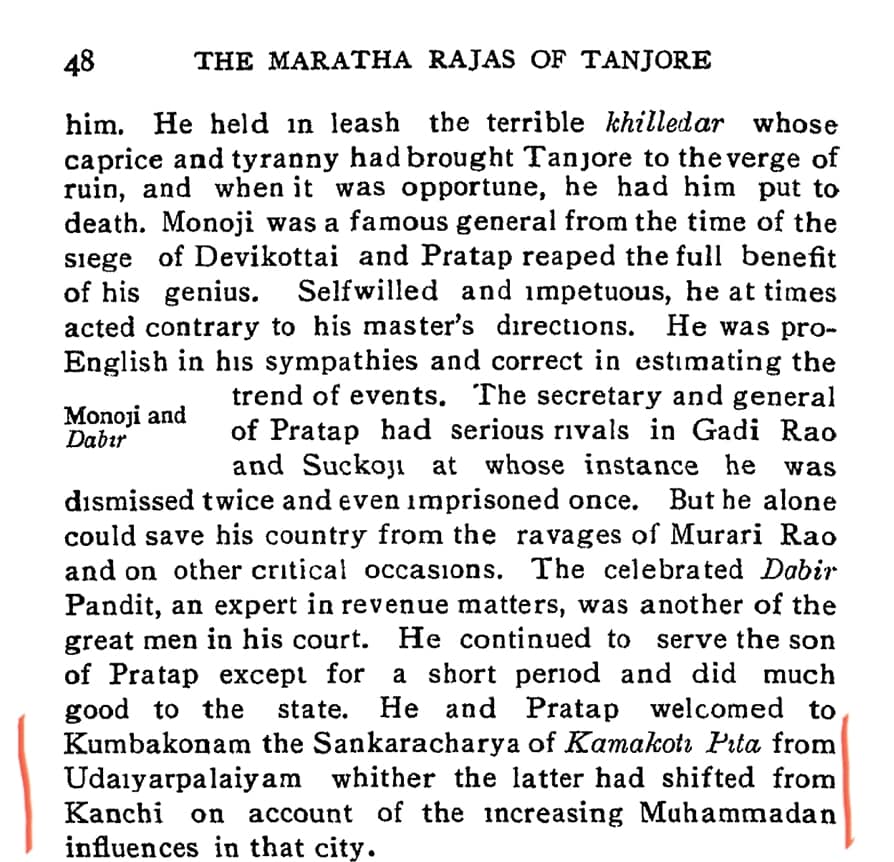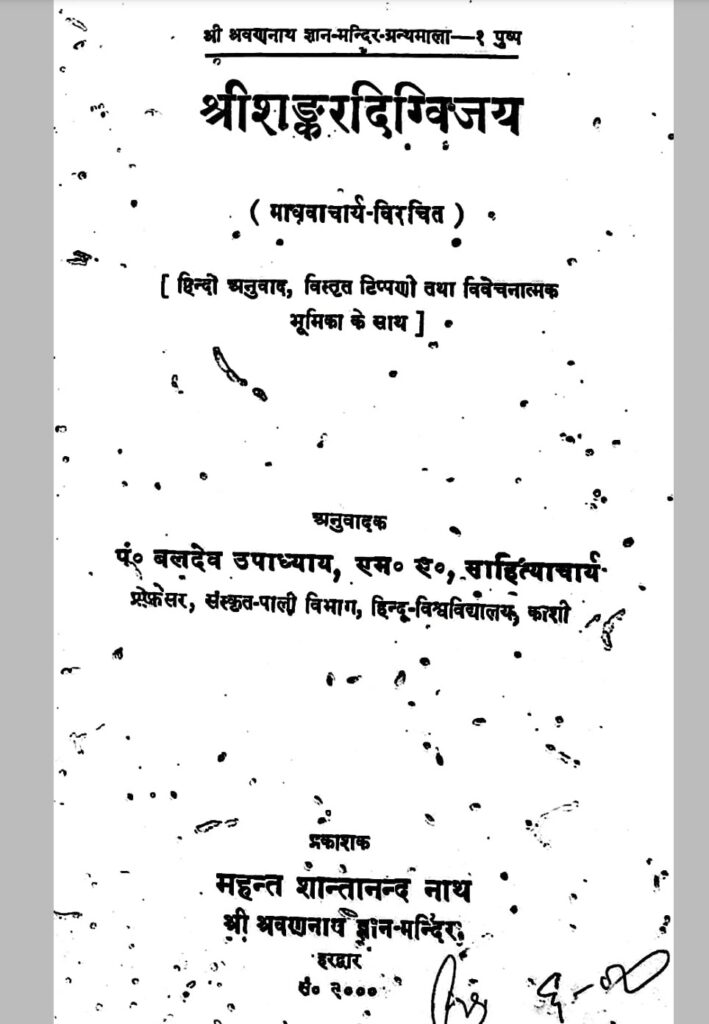
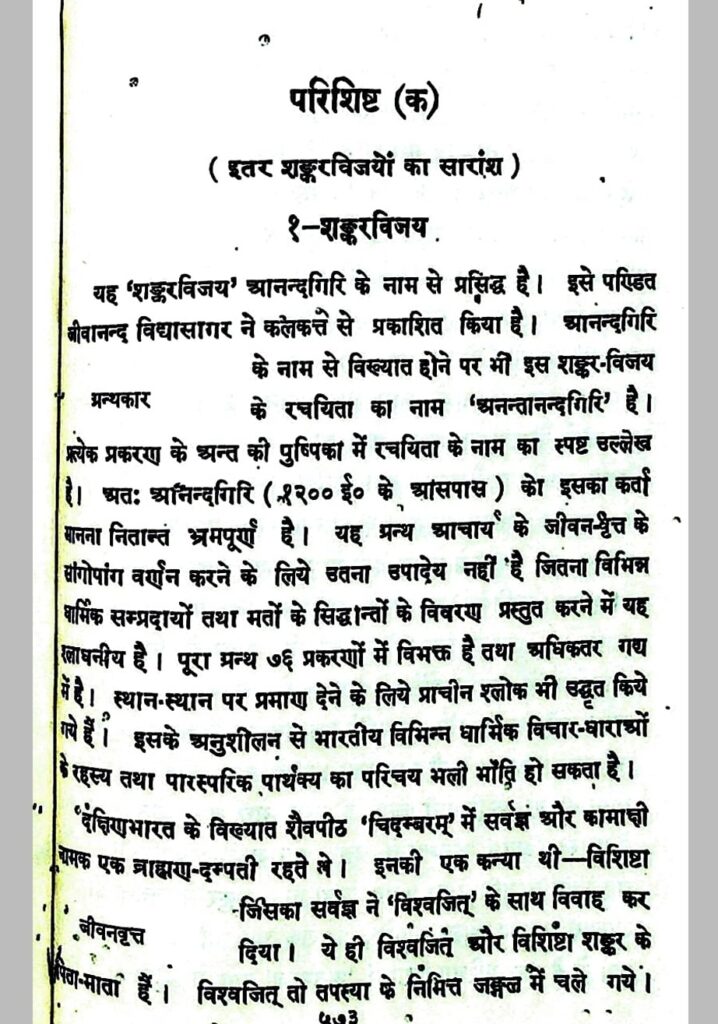
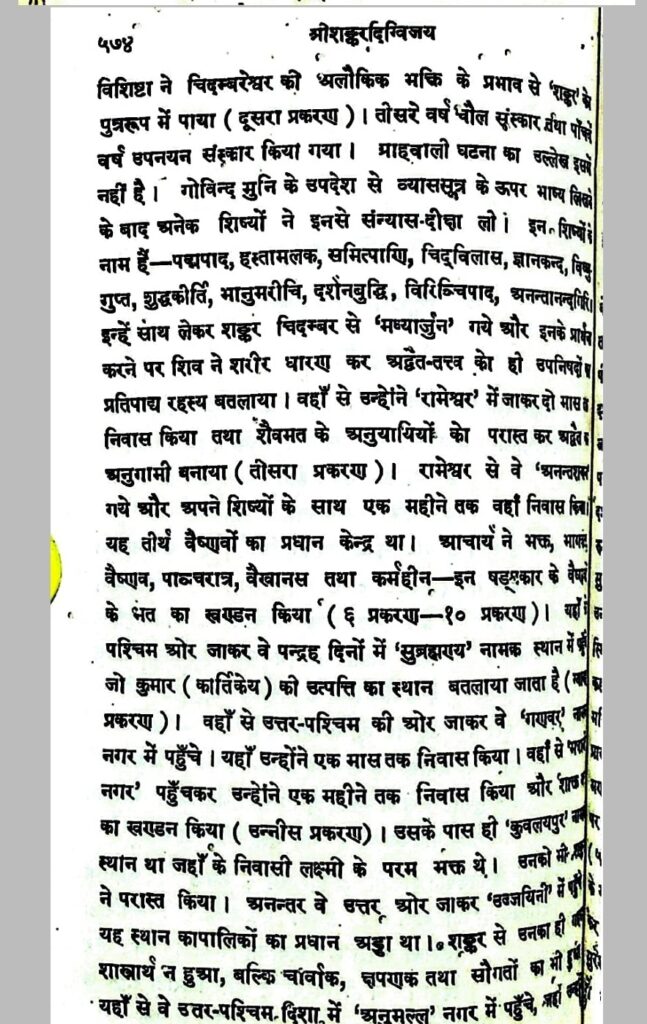
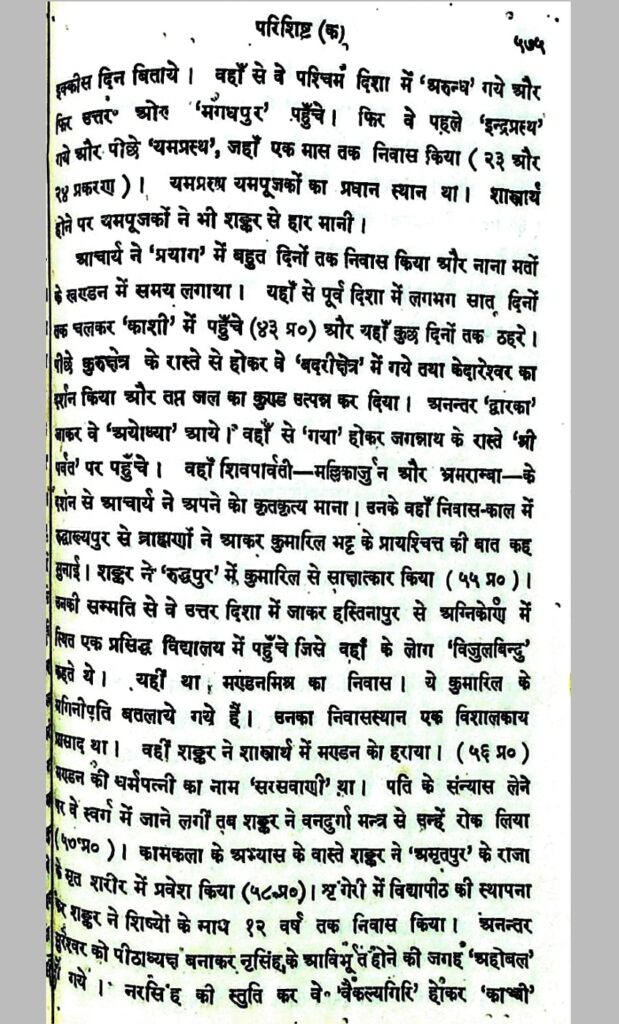
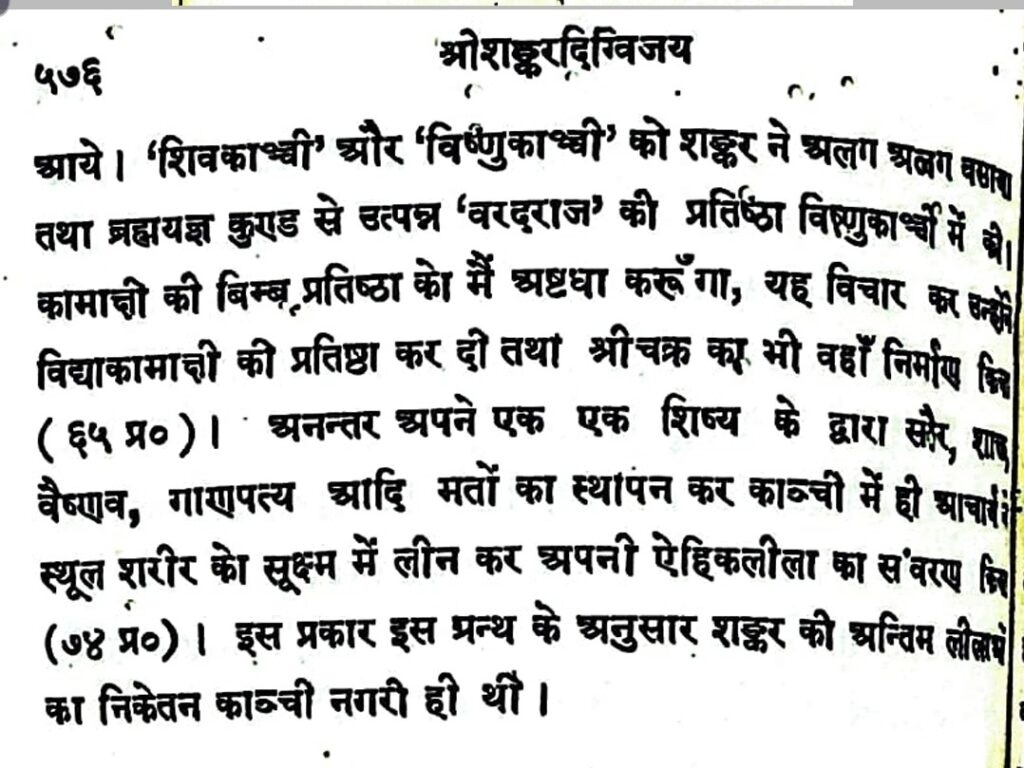





नानाभाष्यादृता सा सगुणफलगतिर्वैधविद्याविशेषै:
तत्तद्देशाप्तिरम्या सरिदिव सकला यत्रयात्यंशभूयम् ।
तस्मिन्नानन्दसिन्धावतिमहति फले भावविश्रान्तिमुद्रा
शास्त्रस्योद्घाटिता यैः प्रणमत हृदि तान्नित्यमाचार्यपादान् ॥
(श्रीमदप्पय्यदीक्षितानां न्यायरक्षामणौ)
“The rivers or the courses of devotion towards the diverse aspects of the Personal God attain their final calm only when they become one with the ocean of bliss (Ananda Sindhu) that unfolds itself at the moment of Ultimate Realization.”
Sri Sankara Bhagavadpada : The Shanmata Sthapanacharya – Shankara And Shanmata
“The celestial wish-yielding tree of Sankara taking its root in the Vedas, and spreading for branches the Shanmatas, gave out to the world at large a rich yield of the fruits of Illumination” thus says Anandagireeya.
“Those who came to scoff remained to pray” said Goldsmith. Those who came as disputants.. the leaders of the various sub-faiths became His disciples.
When Sri Sankara Bhavadpacharya took His abode in Kanchipuram in His last days, He sent out these disciples to propagate the worship of the six divinities within the Vedic framework. They did accordingly and reported back the success of their mission to the Great Acharya.
The 67th and succeeding prakaranas of Anandagiri’s Sankaravijaya, give an account of this. Paramata Kalanala, Lakshmana, Hastamalaka, Divakara, Tripura Kumara and Girijakumara were the disciples who spread the faiths in the different parts of Bharat,
Thus it is clear that Sri Bhagavadpada was Shanmata Sthapaka. He shed off His mortal coils in Kanchi only after the leaders of the six faiths, who were His disciples, reported to Him that the faiths had been stabilised throughout the nation in the new form given by the Achrya which really was their original form.
Iconography
It is significant that Sri Sankaracharya (like Dakshinamurti) is usually represented in sculptures with His four disciples who spread the philosophy of advaita. But, only in Sri Kamakshi Temple (Kamakoshta) and Sri Kanchi Kamakoti Peetam Srimatha (old Puja-griha)- His most important shrines
in Kanchipuram, six disciples are shown in the pedestal/ panel. They are the expounders of the Shanmatas. Two of them are not Sannyasins, their head not covered with cloth. But since they do not have the upavita they could not be brahmacharins or grhastas either. One may conclude they had been tantrics, newly won over to the Smarta tradition.
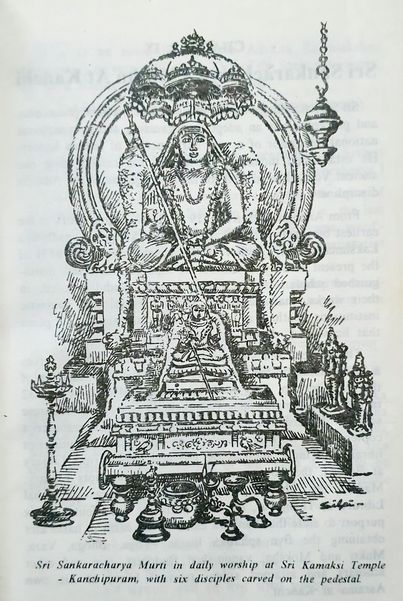
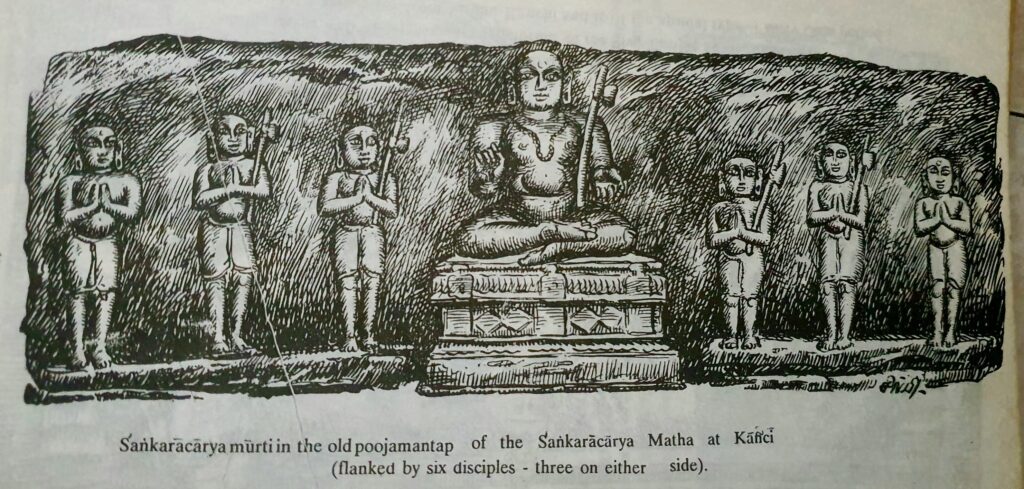
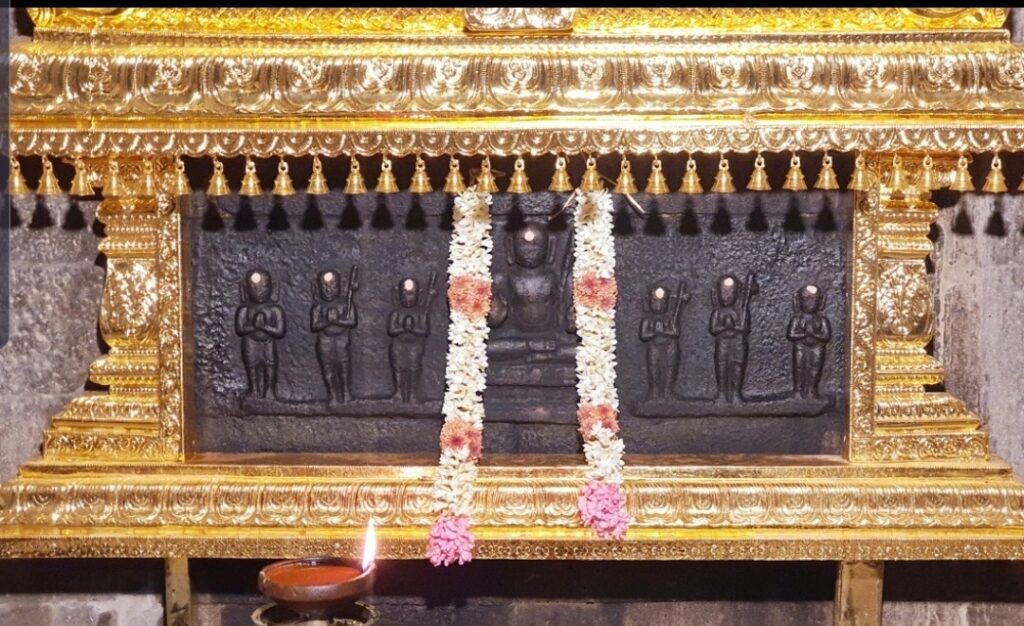
A Note on Tirukkamakkottam
– V.R.Ramachandra Dikshitar [Proceedings of the Indian History Congress (1946)] …2/2
“Tradition avers that Adi Sankara in the course of his digvijaya established mutts at different places and one such place was Kanchi, the modern Conjeevaram.
At Kanchi. Sankara founded what is known as Kamakotipitha. This Pitha of Kamakoti was flourishing here till at least A. D. 1686, and in this connection the temple of Kamakshi in Conjeevaram is said to be the one erected or renovated by Sankara and his disciples.
Even to-day a figure of Sankara is to be seen in this temple, evidently a figure of the first acharya. And Kamakoti is written in inscriptions as Kamakottam.
Kamakottam means the shrine dedicated to the goddess Kamakshi. The cult of Kamakshi must have become popular after Sankara and shrines in her honour were erected and dedicated by kings and pious devotees.
As time went on, the Kamakshi amman koil became generally known as Amman koil. For Parvati or Uma, Minakshi and other names are the names of one and the same goddess. So whatever be the name of the goddess enshrined in a temple, the common people call it even to this day Amman koil.
The revival of Devi worship as Kamakshi must be therefore due to Sankara who founded the Kamakoti pitha in Conjeevaram for the first time. Hence the Kamakottam which we find in the inscriptions. If Kamakottam is the same as Kamakoti, then the institution of Kamakottam must at least go back to the age of Sankara.”
BY V. R. RAMACHANDRA DIKSHITAR, University of Madras. (Part-I)
In a paper contributed to the All India Oriental Conference Nagpur (1946) Mr. K. R. Srinivasan said: ‘In the South Indian temples, Tirukkamakkottam is the name given in inscriptions to the separate shrine dedicated to Parvati or Devi installed and consecrated as the consort of Lord Siva, the presiding deity in a South Indian temple unit’ He further proceeded and remarked that only in the period of the Imperial Cholas the Tirukkamakottam was introduced as a new member and later on grew in importance.
The conclusion arrived at, is based on mere references in the inscriptions, and perhaps also from a study of the temple architecture, and the tentative definition of a temple unit.
According to him till about the eleventh century A. D. there was no place for a separate Amman shrine or shrine for the goddess.
We are afraid that this theory of a separate Amman shrine as a later addition and that from about the eleventh century cannot be readily admitted. This is to ignore all tradition, literary and oral.
We must first examine the term Tirukkamak-kottam or simply Kamakkottam, tiru meaning sacred. The origin of this expression will be indeed significant for our investigation. It may be a very ancient one but it became very much popular certainly after the Adi Sankaracharya. (1/2)
“Since the date (of Sri Sankara Bhagavadpada) arrived at independently from internal evidence agrees, with remarkable exactness, with the date preserved in three of the Mutts, and since the Hultzsch list totally disagrees with the Sringeri list we are led to surmise that there must exist some records within the archives of the Mutt which have not been properly and carefully scrutinised or has seen the light of day. It is hoped that the authorities of the Mutt would afford facilities for real workers with true historical instinct to obtain a peep into them.”
(Extracted from the Article Sri Samkaracharya By Vaidyavisarada K.G.Natesa Sastri, B.A., M.R.A.S. published in Jignasa, Vol.1-4, 1927)
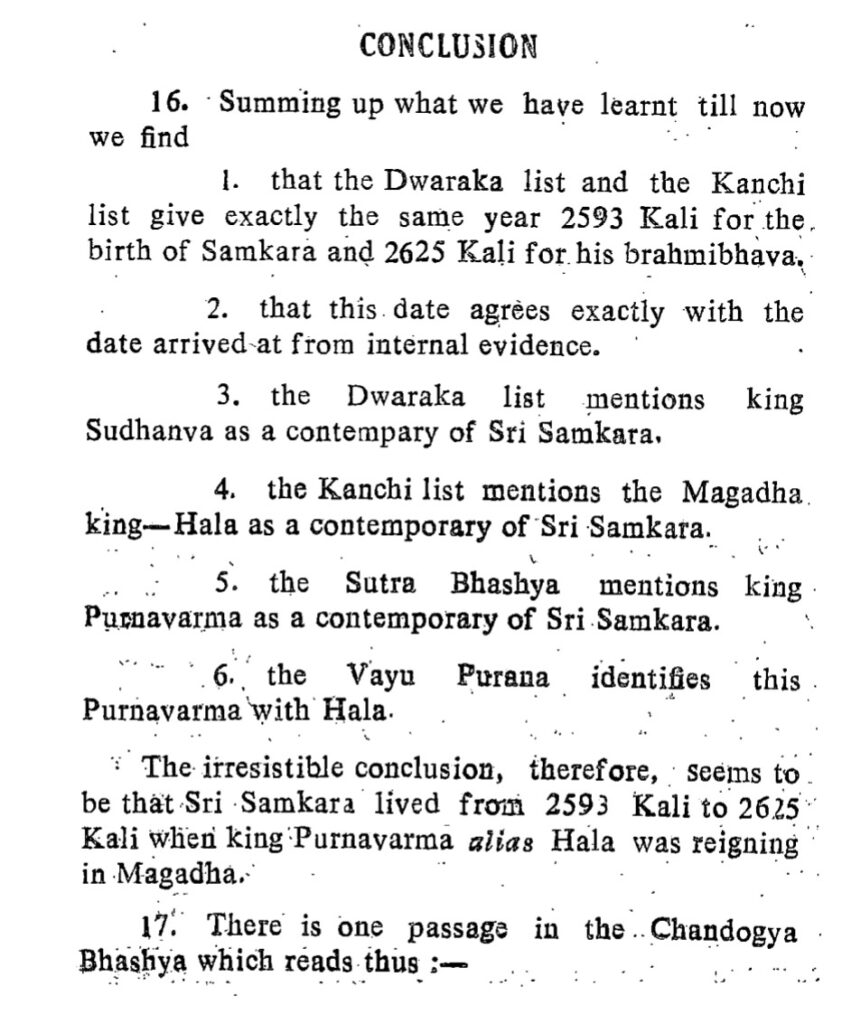
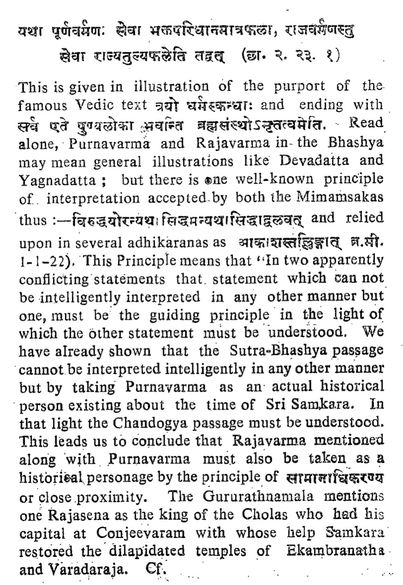
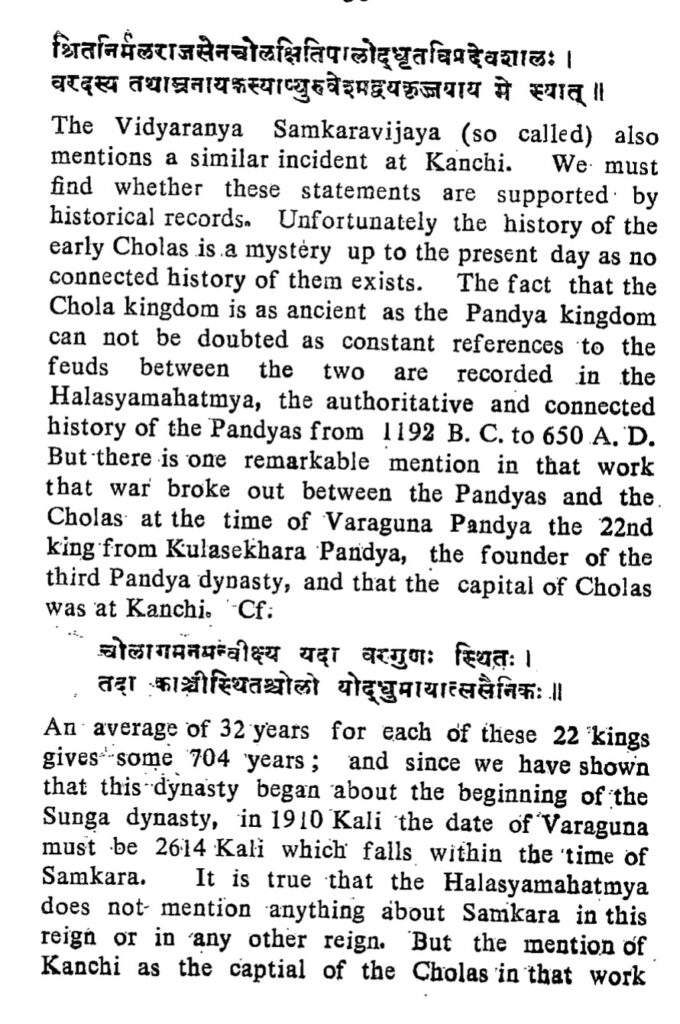
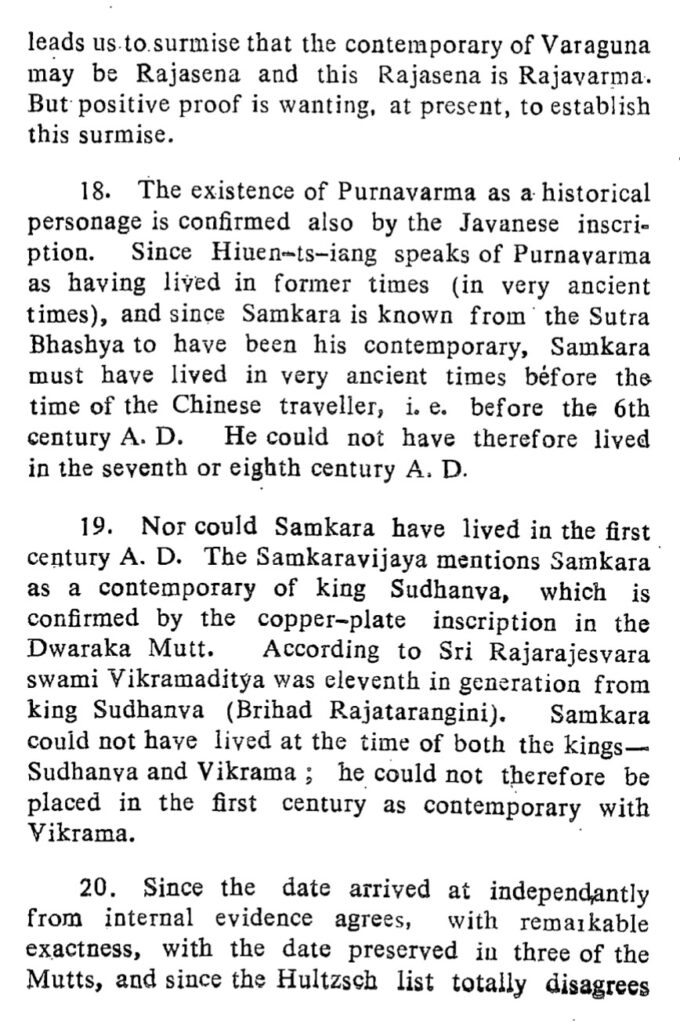
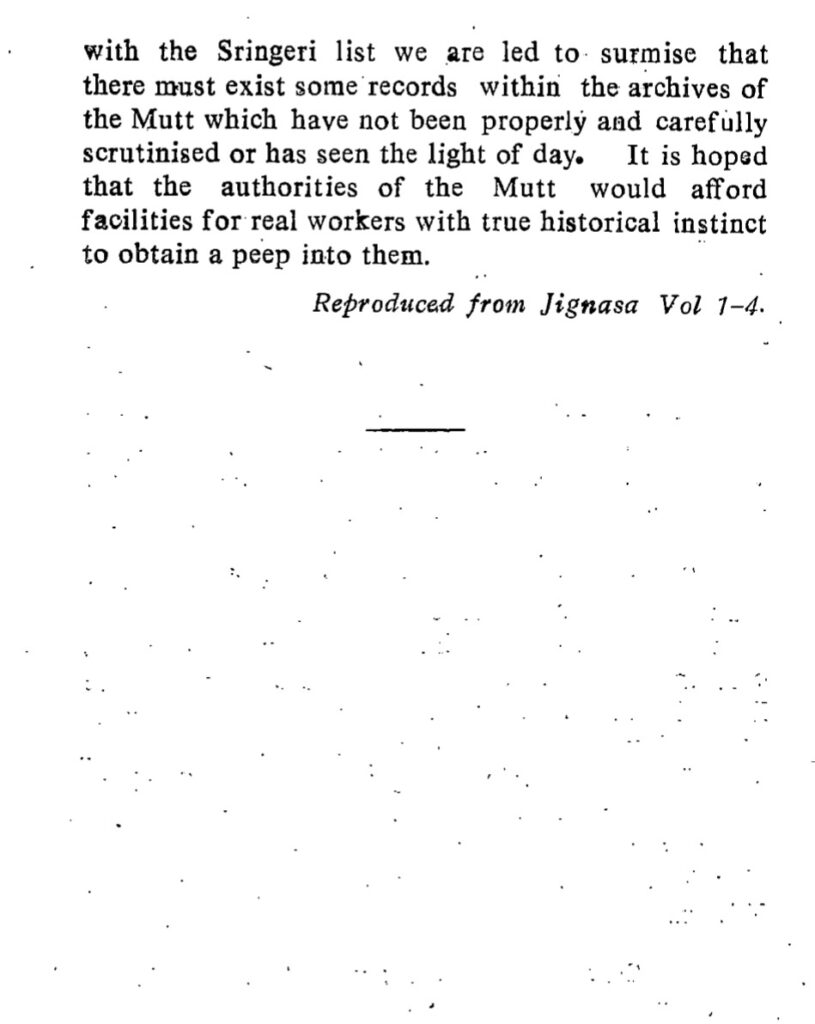
” The extraordinary composure of mind exhibited by his writings forms a striking contrast to those of the other reformers and philosophic writers, and would induce any reader to think that he had nothing to do with Buddhist or any other persecutions as Mr. A. Barth represents when he says that the disciples of Sri Sankaráchárya “Organized into military bands and constituted themselves the rabid (!) defenders of orthodoxy.”
With the exception perhaps of this single writer, every one else firmly believes that he was too philosophical to have hand in those persecutions.
Lastly, towards the end of his life he came to the south, but had to leave his body and this world in Conjeveram, at the early age of thirty-two. We think Conjeveram was the most probable place (of his Nirvana, for at present there is an image of him in the temple of the famous goddess Kámákshi, and judging from the style of architecture and the local traditions to the effect that his body lies buried underneath the image, which is now worshipped.
For Sri Sankaráchárya and his works we have a very high reverence. The loftines calmness, and firmness of his mind, the impartiality with which he deals with the various questions, his clearness of expression – all of these make us revere the philosopher, more and more:.”
– Pandit N.Bhashyacharya,
Adyar Oriental Library
10th October, 1889
Rajah Pratapsingh (1740-1763 C.E) came to know that the Jagadguru Sankaracharya had to abdandon their main Matha at Kanchi, travelled upto Travancore and returned to the forests of Odayarpalayam zamin, which was on the borders of Thanjavur territories where Golden idol Sri Bangaru Kamakshi was safely placed.
He sent his brother-in-law and commander-in- Chief Mallari Gade Rao and one of his ministers Dabir Panth requesting the Acharya to come over to his territory for His residence. Later, the Sankaracharya Swami reached Thanjavur. The Raja assured Him full security and requested the Acharya to make Thanjavur his abode. The Achaya after a brief stay in the fort preferred to shift to the banks of Cauvery in Kumbakonam.
The Rajah built a grand matha for him and a temple for his deities. 36 villages were endowed for its maintenance. Since then the Kanchi Acharya came to live permanently in Tanjore kingdom.
King Pratap Singh also made several endowments for performing nitya puja to the Adhishtanam of Sri Paramasivendra Saraswati Swamy, the 57th Acharya of Sri Kamakoti Peetha, the Preceptor of Sri Sadasiva Brahmendra.
The modi records of Tanjore kingdom contain details about monetary contributions and other offerings during Vyasa pooja and special occasions to Sri Kanchi Peetha from 1768 C.E.
A permanent ‘madhyasta’ seat had been held in the Royal Darbar by a representative of the Srimatha. The annual tribute and special offerings from the Tanjore palace were submitted through the madhyasta of Srimatha.
Arrangements were also made for the regular collection of “Sankaracharya Sambhavana” from all communities of the Tanjore country. This alongwith the land revenue and paddy collection from almost all villages of the country was remitted to the Matha directly by the revenue officials of the respective Taluk.
Apart from these, Mohini and Tasdik allowances were also given to the Matha in respect of the imams resumed during the occupation of Arcot Nawab.
The 1817 C.E records of Col.Mackinzie contain a direct reference about the said usurption of inam villages granted to the Matha, by the earlier kings, by the foreign powers who occupied Tanjore kingdom later. All these would show that the Matha was always revered and held in high esteem by all the Kings of Tanjore Mahratta Raje.
The modi records also mention about frequent exchange of rare manuscripts and books between the Sankaracharya Matha and Tanjore Saraswati Mahal Libraries.
Many old palm leaf manuscripts of the Vyasachala, Anandagiri and Govindanatha Sankaravijayams, Sivarahasyam (procured from Varanasi) etc. were also carefully preserved in the Tanjore palace library by the Kings.
King Tulaja’s relations with Sri Kanchi Kamakoti Srimatha
After Rajah Pratapsingh, his Son Tulaja and after him Serfoji extended all facilities to Mutt. He arranged for shifting of Sri Swarna Kamakshi image to Tanjore fort, from Tiruvarur. He also made several endorsements for the nitya naimittika puja of the deity.
Anandagiri”s Sankaravijayam was translated in Telugu by Andhra Kalidasa, Tulaja’s Court Poet. Govindanatha yati’s Sankaracharya Charita was written on the request made by Deepambika, King Sahaji’s mother.
Serfoji Raja and Kanchi Sankara Mutt
Serfoji attended the Mahamagam festival at Kumbhakonam with all his family members in royal splendour. After holy bath in the Mahamaga Tank, the Rajah visited the Kamakoti pitam Jagadguru Shankaracharya, residing at Kumbakonam and performed padapuja and offered serveral valuable presents to Sri Chandramouleeswara Swamy.
During his visit to the Mutt on the Mahamagam day King Serfoji performed ‘Kanakabhishekam’ (showering of gold coins) to the Sankaracharya. This was the third Kanakabhishekam performed to the Jagadguru Acharyas of Sri Kanchi Kamakoti Peetha, by Their principal disciples, the Mahratta Rajas of Tanjore.
The Swami blessed the King with Holy mantrakshata, valuable shawl and one Gowri Shankar Rudrakshamala studded with rare gems and the most mertitorious title of ‘Siva Puja Dhurandhara’. Serfoji’s son Sivaji II also performed Kanakabhishekams to the Kanchi Acharyas in 1832, 1842 and 1850 C.E.
SOURCES
1. The modi documents translated in to tamil and preserved in the Saraswati Mahal Library, Tanjore. (11 bound volumes )
2. Modi Palakani – Articles published the Journals of the Saraswati Mahal Library, Tanjore.
3. Note Books (48 nos.) containing hints in Tamil pertaining to Modi documents.
4.Administration and Social Life under the Mahratta Rulers of Tanjore by K.M.Venkataramaiah (1984)
5. Mahratti Modi manuscript compilations published by the Tamil University, Tanjore.
6.Inscriptions of the Tanjore Mahrattas by Mr.Rasu.
7.https://www.kamakoti.org/…/Preceptors%20of%20Advaita%20…
“One of the records is 31/C Item 60 subsection 5 from the Modi records from the Sarasvati Mahal Library, Tanjavur. There is a petition where a number of people had made a complaint to the then king of Tanjavur about the alleged misdeeds of some Karyastha of the Matha. This interesting document belongs to the time of Sri Mahadevendra Sarasvati who ascended the Kamakoti Pitha in the year 1851 during the time of the last king Sivaji of Tanjavur; and in this the petitioners in their introductory paragraphs give a brief but interesting account of the Matha. It is stated in the petition as follows:
“The Mutt of Sri Sankaracharya Svamy at Kumbhakonam was a small mutt6 when it was at Kanchipuram. Raja Prataph Singh brought the Sankaracharya from Kanchi and built a Mutt at Dabir Agraharam, granted Mohini lands, offered him his first honour and respect, etc., etc.
This clearly shows that the Matha was shifted from Kanchipuram to Tanjavur during the time of the reign of Raja Pratap Simha of Tanjavur. We have fortunately enough of original documentary evidence of the Tanjavur Maratha rulers themselves to substantiate the above.
There is an order issued by King Pratap Simha of the Tanjavur Maratha Rulers preserved in the Madras Central Record office as Record No. C-37/38-43 of the Tanjavur Palace Records.
This is in Hemadipant Modi script. In this order the king had stipulated that the sambhavana to the Acharya of the Sri Kanchi Kamakoti Pitha should be paid at some uniform specified rates. The Acharya is mentioned as-
“Srimad Paramahamsa Parivrajakacharya Srimad Pujya Sankara Bhagavad
Padacharyanam Adhishthane Simhasane Abhishiktanam Sri Chandrasekhara Sarasvatinam Pujyayoh Sripadayoh.”
In describing the Birudavali of the Acharya the king used the following phrases:
“Srimad Sakala Bhumandalalankara Trayastrimsat Kotidevata Sevita Sri Kamakshi Devisanata Sakshatkara Paramadhisthana, Satyavrata Namankita, Kanchi Divyakshetre Saradamatha Sthitanam”, …
From the above, it will be very clearly seen that the Birudavali of the Sri Kanchi Kamakoti Pitha which is existing today was used in full in 1748 A.D. by King Pratap Simha of Tanjavur. There are a number of other Modi records of the same king and his successors, which go to reveal the great esteem and regard in which the Acharyas were held by Maratha Rulers of Tanjavur.
The question as to why the Sri Kanchi Kamakoti Pitha shifted its headquarters from Kanchipuram to Kumbhakonam arises for consideration.
That the Pitha was established by Adi Sankara at Kanchipuram and that it has been continuing in an unbroken line of great Acharyas is clear from the other evidence already shown here. As to why and when the Pitha shifted its headquarters to Kumbhakonam, we have clear evidence in another important public record.
This is about a court case belonging to the times of 64th Acharya of the Pitha. In the year 1844 A.D., the authorities of Sri Sringeri Matha filed a civil suit in the Trichi District Sadar Amin Court that the right for the Tatanka Pratishtha of Goddess Akhilandesvari belonged only to that Matha. Sri Kanchi Kamakoti Pitha was made the first defendant in the above civil suit.
The plaint of the plaintiff, the answer of the first defendant, the reply of the plaintiff for this and the defendant’s rejoinder, the evidence presented by both sides and the judgment, are all now available to us in print. Ultimately the court decided that the documents submitted on behalf of the Sringeri Matha were not reliable and that the oral evidence adduced on their behalf was self-contradictory and the suit was dismissed with costs.
This suit bears the number O. S. 95/1844. This was taken in appeal No. 109/1846 and in special appeal petition No. 106/1848 to higher courts and in both the appeals the Sringeri Matha’s claims were disallowed with costs to this defendant. This one record is more than enough to give us a graphic insight into the affairs of Sri Kanchi Kamakoti Pitha about 120 years ago.
This record contains an important point of reference. In this rejoinder of the Sri Kanchi Kamakoti Pitha, para 20, the reasons for the shift of the Matha from Kanchipuram to Kumbhakonam are clearly given.
The following is a free translation of the relevant passage:
“The plaintiff in column 20 of his reply states that if it is true that the Kamakoti Pitha was established at Kanchipuram by Sankara and if Sankara’s disciple was installed there, the first defendant should still be residing there only and the reason for his residence at Kumbhakonam has not been stated in the defendant’s answer. It is not stated in any authoritative text that the Kamakoti Pithadhipati must necessarily live only at Kanchipuram and should not take up his residence in any other place.
The first defendant’s disciples and other staff of the Matha are still living in the Kanchipuram Matha and are still carrying on the daily Puja to the Sarvajna Pitha there. The first defendant’s Parama guru (that is Guru’s Guru) wanted to reside on the banks of the river Cauvery and hence came to reside in Kumbhakonam. He brought along with him the Yogalinga Chandramaulisvara Svami, consecrated by Suresvaracharya. The local Rajahs and other disciples afforded every facility and convenience to him and hence he used to alternate his residence between Kumbhakonam and Kanchipuram, etc., etc”.
The above clearly gives the reason as to why Sri Kanchi Kamakoti Pitha was shifted to Kumbhakonam.
This record belongs to the time of the 64th Acharya, Sri Chandrasekharendra Sarasvati V. He was the head of the Pitha from 1814 to 1851 A.D. His Parama Guru was the 62nd Acharya, Sri Chandrasekharendra Sarasvati IV who adorned the Pitha from 1746 to 1783 A.D.
It was this Acharya, who shifted his headquarters from Kanchipuram to Kumbhakonam in order to carry out his meditation and worship on the peaceful banks of the river Cauvery. He attained Siddhi in 1783 A.D. in Kumbhakonam itself.
The traditional accounts of the shift of the Matha from Kanchipuram to Kumbhakonam assign it to the period of King Pratapa Simha, one of the Tanjavur Maratha Rulers who was a great devotee of the Acharya.
This has been clearly corroborated by the Modi document of 1750 A.D. mentioned above. This king ruled between 1740 and 1768 A.D. This traditional account of the shift of the Matha, is fully borne out by the statement made in the court documents mentioned above. It is thus clear that in the latter half of the 18th century, the Matha was shifted from Kanchipuram to Kumbhakonam.”

King Pratap Singh (1740-1763) of invited the Jagadguru Sankaracharya of Sri Kanchi Kamakoti Peetha to Tanjore Mahratta kingdom during the invasion and occupation of Tondaimandalam.
“During the muslim invasion and occupation of Conjeepuram and the sorroundings, Pratapsingh brought JagadGuru Shankarachariya swamigal of Kanchi Kamakoti Peetam to Thanjavur and provided him a Mutt at Kumbakonam endowing it with 27 villages for its maintenance.” [Page 36]
(Rajah Serfoji II – Short History of Tanjore Mahrattas By Prince Thulajendra Raja P. Bhosale, Tanjore.)
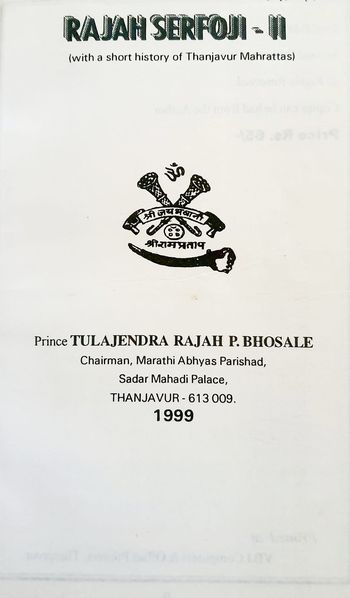
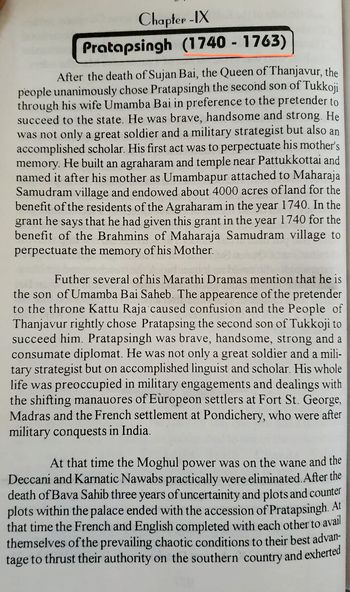
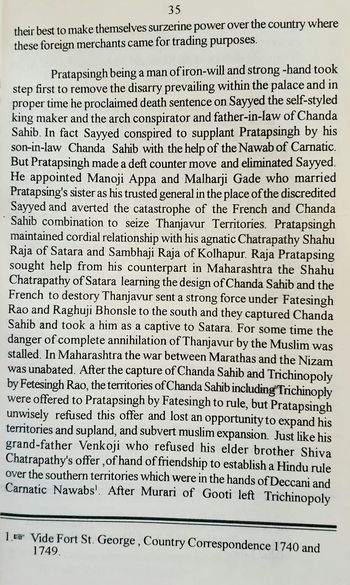
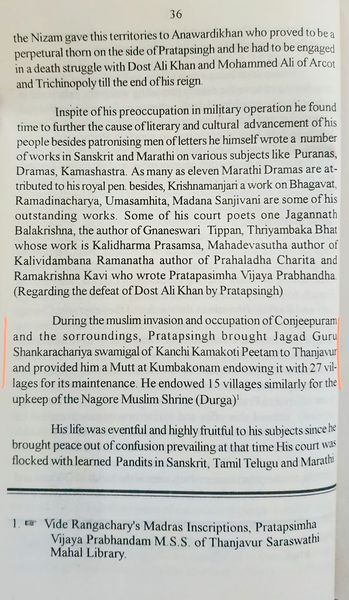
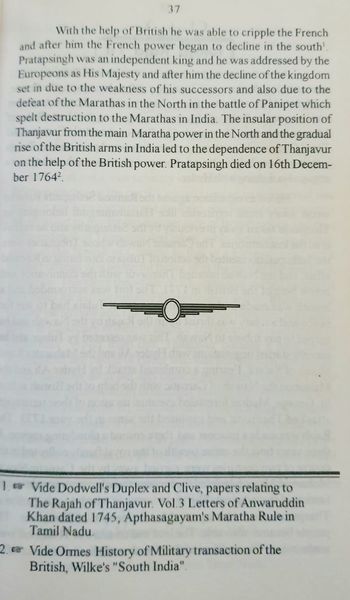
PRATAP SINGH (1739 -1763 C.E.)
” He (Manoji) and Pratap welcomed to Kumbakonam, the Sankaracharya of Kamakoti Pita from Udayarpalaiyam whither the latter had shifted from Kanchi on account of the increasing Muhammadan influences in that city.”
[The Maratha Rajas of Tanjore By
K. R. SUBRAMANIAN, M.A. With A Foreword By P.T.SRINIVASA IYENGAR., M.A., L.T., Reader in Indian History, University of Madras, (1928).]
